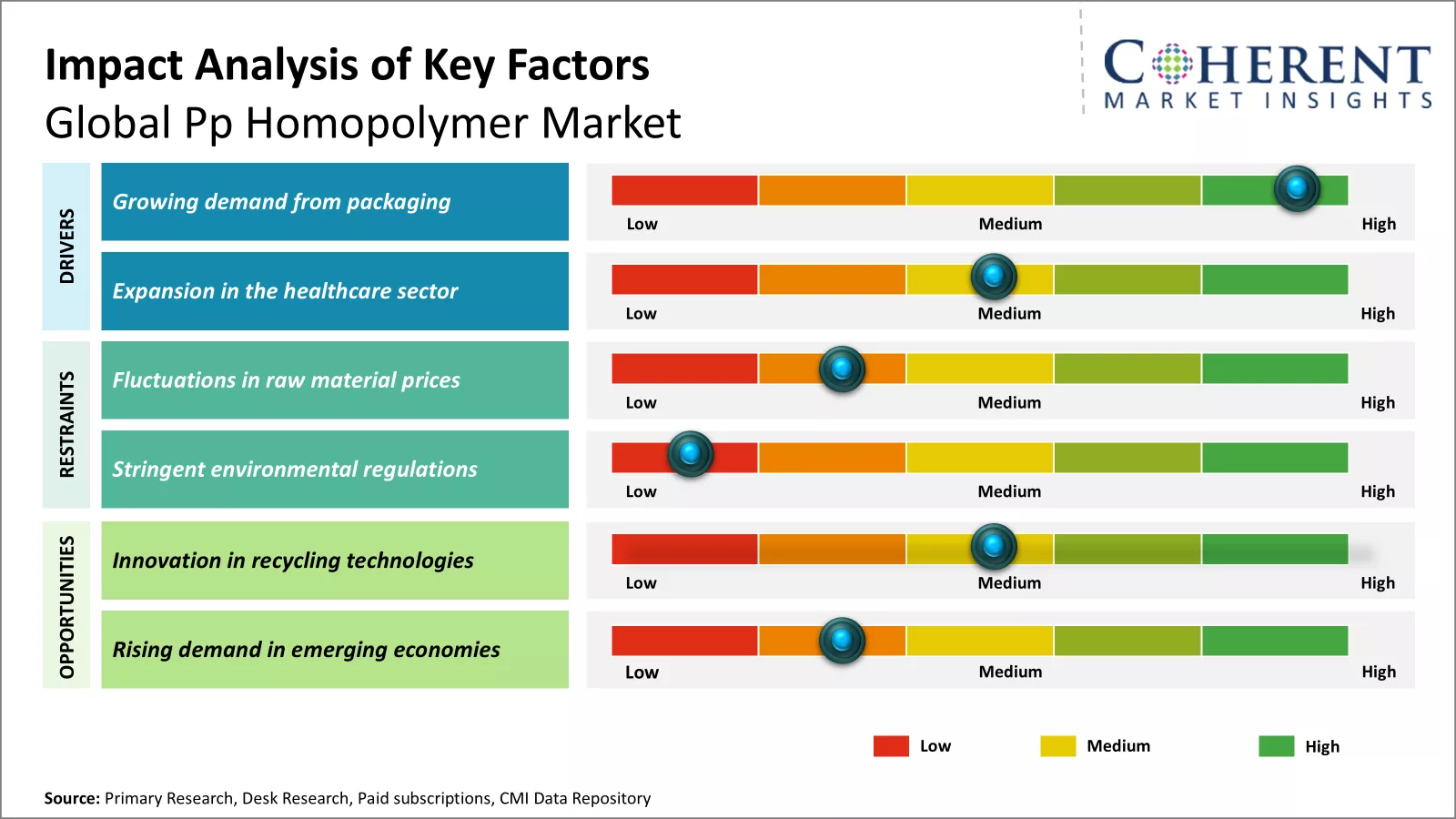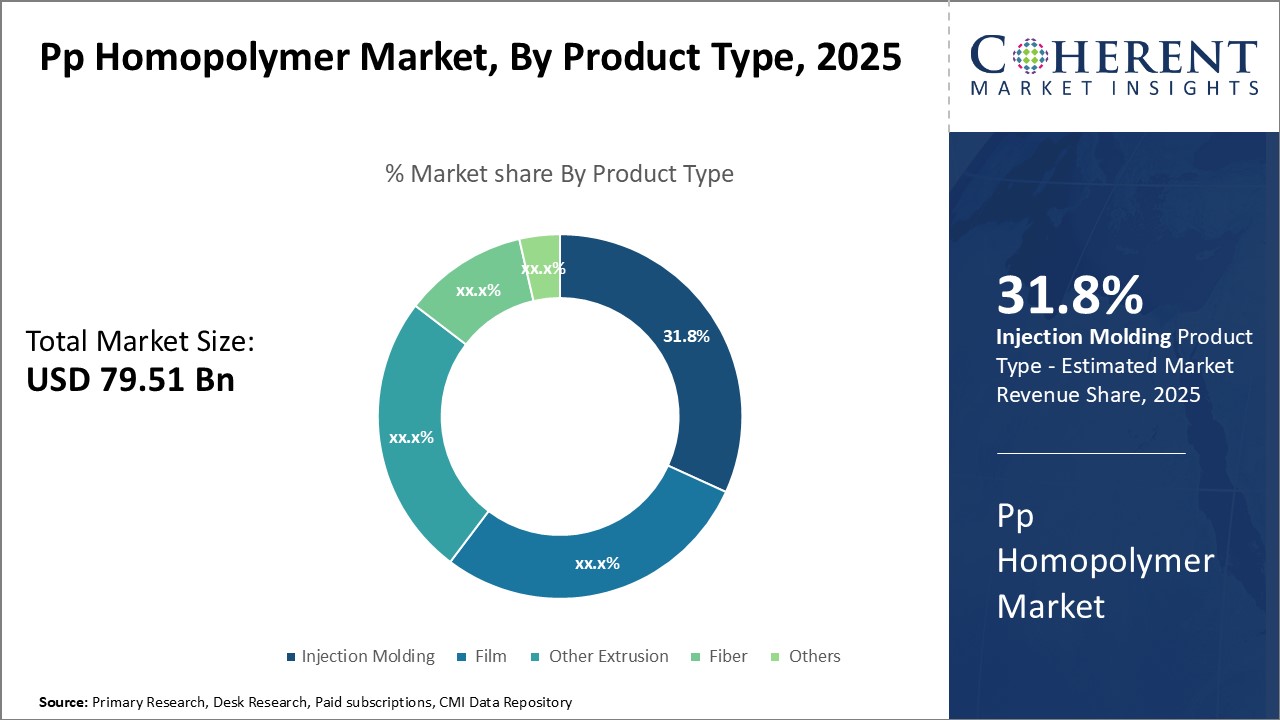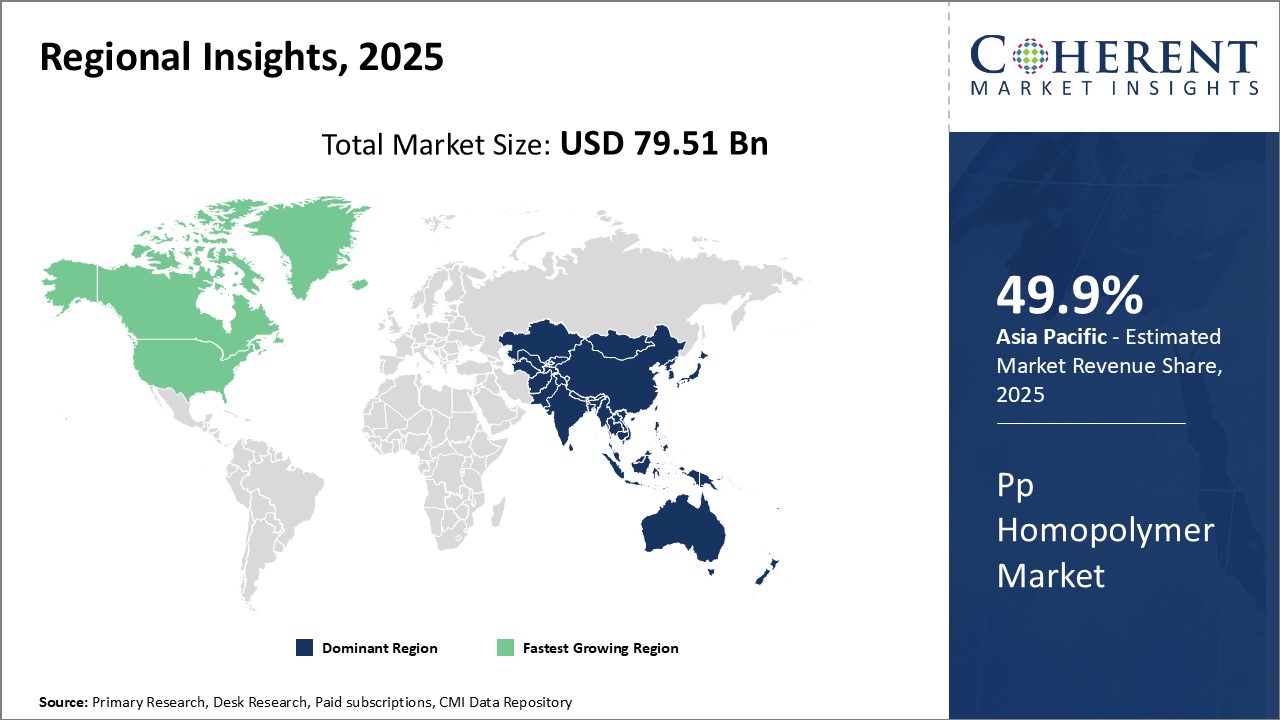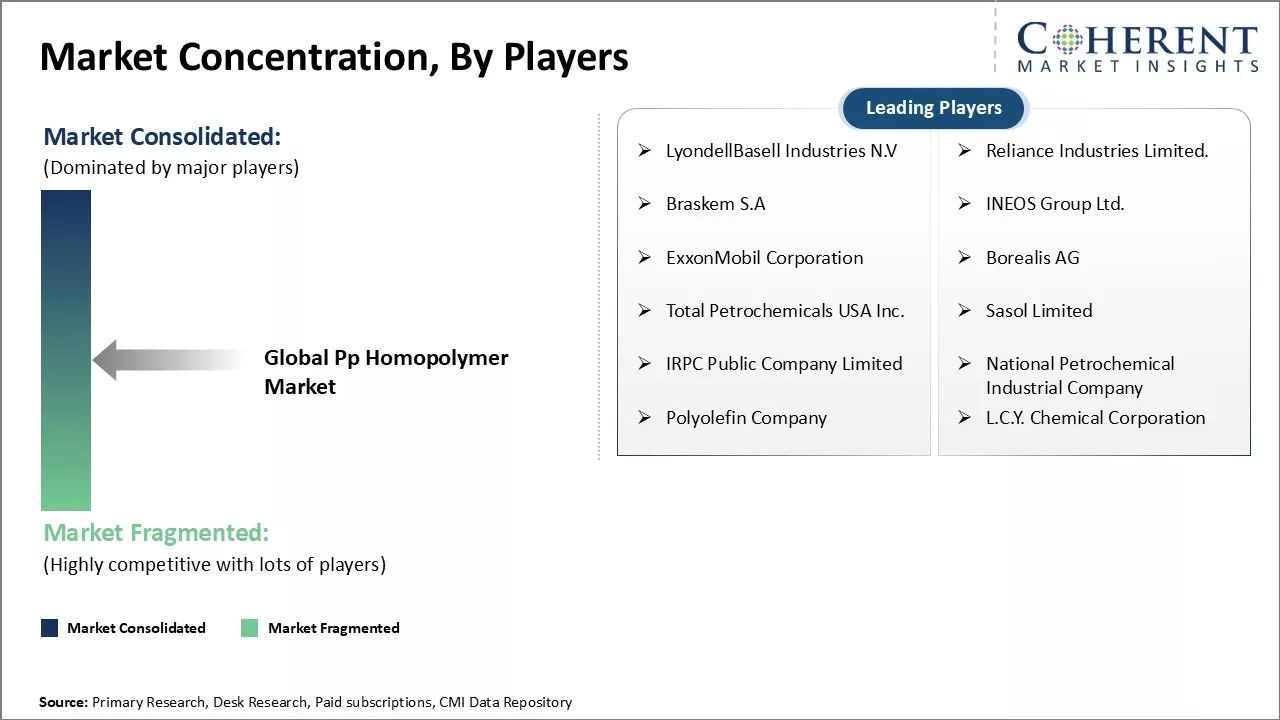The global Pp homopolymer market is estimated to be valued at USD 79.51 Bn in 2025 and is expected to reach USD 106.83 Bn by 2032, exhibiting a compound annual growth rate (CAGR) of 4.3% from 2025 to 2032.

Discover market dynamics shaping the industry: Request sample copy
Increasing demand from the packaging industry is one of the key factors driving the market growth. Pp homopolymer finds wide applications in plastic bags, bottles, and containers due to its properties like toughness, clarity, and chemical resistance. Moreover, growth in e-commerce is also boosting the demand for plastic packaging solutions. However, stringent environmental regulations regarding plastic usage and growing preference towards eco-friendly alternatives may hinder the market growth to some extent over the forecast period.

Discover high revenue pocket segments and roadmap to it: Request sample copy
Insights By Product Type: Injection Molding dominates owing to its wide application range
In terms of product type, Injection Molding segment is estimated to contribute the highest market share of 31.8% in 2025, owing to its wide range of applications and versatility and ability to produce complex parts in high volumes. The automotive industry is a major consumer of injection moulded PP homopolymer parts. Components such as instrument panels, consoles, trims, and fittings are commonly injection moulded from PP.
Insights By End-use Industry: Evolving consumer preferences boost the packaging segment growth
In terms of end-use industry, packaging segment is estimated to contribute the highest market share of 26.8% in 2025, owing to evolving consumer preferences. Evolving consumer lifestyles and preferences are a key growth driver. Working professionals demand packaged foods, beverages, and household goods convenient for on-the-go consumption. PP packaging preserves freshness without compromising visibility of contents. Its rigidity allows stackable and space-efficient designs.

Need a Different Region or Segment? Customize now
Regional Analysis
Dominating Region: Asia Pacific
Asia Pacific is expected to dominate the market in 2025 with an estimated share of 49.9%. Asia Pacific’s dominance in the Pp homopolymer market can be attributed to robust municipal infrastructure investment and construction spending in the region. Countries such as India and China have established manufacturing bases for polymer resins, driving regional production capacities.
Fastest-Growing Region: North America
North America exhibits the fastest growth on account of the region's rapidly developing industrial and packaging sectors. Countries, such as the U.S. and Canada, are witnessing expansion in consumer goods and food & beverage industries, spurring conversions from alternative materials to homopolymers.
Pp Homopolymer Market Outlook for Key Countries
Infrastructure Investment and Sustainability Trends in the U.S.
Polypropylene is extensively used in various sectors, including building and construction, automotive, and packaging. Its properties such as durability, resistance to environmental factors, and cost-effectiveness make it a preferred choice for infrastructure projects. In 2021, domestic demand for polypropylene in the U.S. and Canada peaked at nearly 7.1 million metric tons, reflecting a significant increase in infrastructure development and construction activities
China Continues to Lead Growth through Manufacturing Shifts and Policy Support
The Chinese government has implemented policies such as the "Made in China 2025" initiative, aiming to enhance domestic manufacturing capabilities and promote high-tech industries. China's GDP growth rate for 2023 is projected to be around 5.6%, with manufacturing being a key contributor, accounting for approximately 27.5% of GDP. China is the largest producer of polypropylene globally, with production capacity exceeding 20 million metric tons per year, driven by significant investments in petrochemical facilities.
Growing Demand for PP Homopolymers in Canada's Automotive and Packaging Sectors, Driven by Sustainability Initiatives
The automotive industry is a significant consumer of PP homopolymers in Canada, utilizing them for various components due to their lightweight and durable properties. Additionally, the packaging sector is expanding, particularly in flexible packaging solutions, which is expected to boost demand for PP homopolymers. Canadian manufacturers are increasingly focusing on sustainable practices, with a growing emphasis on recycling and the use of recycled materials in production processes.
Japan's Packaging and Automotive Industries Drive PP Homopolymer Consumption Amid Manufacturing Innovations
The packaging industry is the largest consumer of PP homopolymers in Japan, accounting for about 30.5% of total consumption. The automotive sector also plays a crucial role, with PP homopolymers used in interior and exterior components due to their excellent impact resistance and lightweight characteristics. Japan is known for its technological innovations in manufacturing processes, which enhance the efficiency and quality of PP homopolymer production. This includes advancements in injection molding techniques that improve product design and functionality.

Get actionable strategies to beat competition: Request sample copy
Top Strategies Followed by Global Pp Homopolymer Market Players
Emerging Startups in the Global Pp Homopolymer Market
Innovative Technologies:
Startups are advancing through technologies like bio-based polymers. Spain's NaturePlast develops homopolymers from sugarcane which reduces the carbon footprint by 80% compared to fossil fuel-based variants. U.S.-based, Carbios, creates enzymatic recycling solutions that break down plastic waste into its original monomers. This facilitates infinite recycling of resources. Partnerships with manufacturers and brands looking to enhance their sustainability profiles are becoming common.
Sustainable Solutions:
Firms create eco-friendly options. Canada's Loopeer developed a homopolymer formulated using recycled plastic packaging waste. It removes non-recyclable used plastic from the waste stream. India's Vaishnavi Bio-Tech produces biodegradable homopolymers from agricultural waste, lessening environmental pollution. Agilyx is a pioneer in chemical recycling, transforming plastic waste into usable feedstocks, including for PP production. Their innovative process can handle a variety of plastic types.
Key Takeaways from Analyst
Pp Homopolymer Market Report Coverage
| Report Coverage | Details | ||
|---|---|---|---|
| Base Year: | 2024 | Market Size in 2025: | USD 79.51 Bn |
| Historical Data for: | 2020 To 2024 | Forecast Period: | 2025 To 2032 |
| Forecast Period 2025 to 2032 CAGR: | 4.3% | 2032 Value Projection: | USD 106.83 Bn |
| Geographies covered: |
|
||
| Segments covered: |
|
||
| Companies covered: |
LyondellBasell Industries N.V, Reliance Industries Limited., Braskem S.A, INEOS Group Ltd., ExxonMobil Corporation, Borealis AG, Total Petrochemicals USA Inc., Sasol Limited, IRPC Public Company Limited, National Petrochemical Industrial Company, Polyolefin Company, and L.C.Y. Chemical Corporation |
||
| Growth Drivers: |
|
||
| Restraints & Challenges: |
|
||
Uncover macros and micros vetted on 75+ parameters: Get instant access to report
Market Driver - Growing Demand from Packaging
The global demand for Pp homopolymer has been steadily rising over the past few years primarily driven by its widespread usage in the packaging industry. For instance, according to the U.S. Environmental Protection Agency (EPA) data reported in April 2024, plastic packaging contributes to over 30% of the total plastic demand globally and demand is projected to grow in the coming years.
Market Challenge - Fluctuations in raw material prices
Fluctuations in raw material prices have been one of the major restraints affecting the growth of this market. The prices of crude oil and natural gas, which are the raw materials for producing propylene, tend to be highly volatile in the international markets. For example, according to data from the U.S. Energy Information Administration, the yearly average price of West Texas Intermediate crude oil increased from US$ 46 per barrel in 2020 to US$ 94 per barrel in March 2022.
Market Opportunity - Innovation in Recycling Technologies
This market finds a significant opportunity in advancing recycling technologies. Currently, minimal post-consumer Pp waste is recycled due to contamination, resulting in resource wastage and environmental harm. A 2023 United Nations Environment Programme report highlights that investments in automated sorting with near-infrared and X-ray detection have notably enhanced the purity of sorted plastic streams. As the availability of recycled PP homopolymer resins increases, more product manufacturers are incorporating these sustainable materials into their offerings.
Share
Share
About Author
Yash Doshi is a Senior Management Consultant. He has 12+ years of experience in conducting research and handling consulting projects across verticals in APAC, EMEA, and the Americas.
He brings strong acumen in helping chemical companies navigate complex challenges and identify growth opportunities. He has deep expertise across the chemicals value chain, including commodity, specialty and fine chemicals, plastics and polymers, and petrochemicals. Yash is a sought-after speaker at industry conferences and contributes to various publications on topics related commodity, specialty and fine chemicals, plastics and polymers, and petrochemicals.
Missing comfort of reading report in your local language? Find your preferred language :
Transform your Strategy with Exclusive Trending Reports :
Frequently Asked Questions
Joining thousands of companies around the world committed to making the Excellent Business Solutions.
View All Our Clients
US Reciprocal Tax Impact Analysis On Pp Homopolymer Market
Stay updated on tariff changes with expert insights and timely information